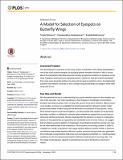A model for selection of eyespots on butterfly wings
Date
04/11/2015Metadata
Show full item recordAbstract
Unsolved Problem The development of eyespots on the wing surface of butterflies of the family Nympalidae is one of the most studied examples of biological pattern formation. However, little is known about the mechanism that determines the number and precise locations of eyespots on the wing. Eyespots develop around signaling centers, called foci, that are located equidistant from wing veins along the midline of a wing cell (an area bounded by veins). A fundamental question that remains unsolved is, why a certain wing cell develops an eyespot, while other wing cells do not. Key Idea and Model We illustrate that the key to understanding focus point selection may be in the venation system of the wing disc. Our main hypothesis is that changes in morphogen concentration along the proximal boundary veins of wing cells govern focus point selection. Based on previous studies, we focus on a spatially two-dimensional reaction-diffusion system model posed in the interior of each wing cell that describes the formation of focus points. Using finite element based numerical simulations, we demonstrate that variation in the proximal boundary condition is sufficient to robustly select whether an eyespot focus point forms in otherwise identical wing cells. We also illustrate that this behavior is robust to small perturbations in the parameters and geometry and moderate levels of noise. Hence, we suggest that an anterior-posterior pattern of morphogen concentration along the proximal vein may be the main determinant of the distribution of focus points on the wing surface. In order to complete our model, we propose a two stage reaction-diffusion system model, in which an one-dimensional surface reaction-diffusion system, posed on the proximal vein, generates the morphogen concentrations that act as non-homogeneous Dirichlet (i.e., fixed) boundary conditions for the two-dimensional reaction-diffusion model posed in the wing cells. The two-stage model appears capable of generating focus point distributions observed in nature. Result We therefore conclude that changes in the proximal boundary conditions are sufficient to explain the empirically observed distribution of eyespot focus points on the entire wing surface. The model predicts, subject to experimental verification, that the source strength of the activator at the proximal boundary should be lower in wing cells in which focus points form than in those that lack focus points. The model suggests that the number and locations of eyespot foci on the wing disc could be largely controlled by two kinds of gradients along two different directions, that is, the first one is the gradient in spatially varying parameters such as the reaction rate along the anterior-posterior direction on the proximal boundary of the wing cells, and the second one is the gradient in source values of the activator along the veins in the proximal-distal direction of the wing cell.
Citation
Sekimura , T , Venkataraman , C & Madzvamuse , A 2015 , ' A model for selection of eyespots on butterfly wings ' , PLoS One , vol. 10 , no. 11 , e0141434 . https://doi.org/10.1371/journal.pone.0141434
Publication
PLoS One
Status
Peer reviewed
ISSN
1932-6203Type
Journal article
Description
The authors acknowledge financial support from the EPSRC grant EP/J016780/1. AM and CV acknowledge financial support from the Leverhulme Trust Research Project Grant (RPG-2014-149). This research was started while CV was visiting Japan as a 2013 Japanese Society for the Promotion of Science (JSPS) Summer Fellow (http://www.jsps.go.jp/). This research was finalized whilst TS, CV and AM were participants in the Isaac Newton Institute Program, Coupling Geometric PDEs with Physics for Cell Morphology, Motility and Pattern Formation. This work (AM) has received funding from the European Union Horizon 2020 research and innovation programme under the Marie Sklodowska-Curie grant agreement No 642866. AM was partially supported by a grant from the Simons Foundation.Collections
Items in the St Andrews Research Repository are protected by copyright, with all rights reserved, unless otherwise indicated.

